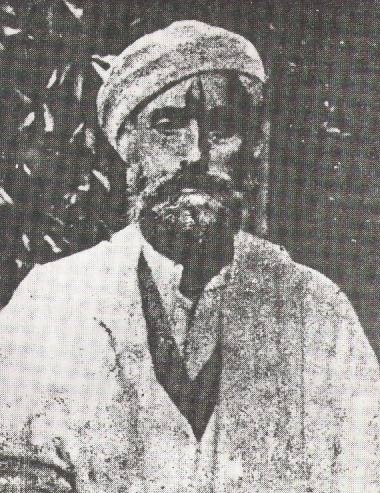Pandit
Harabhatta Shastri
'The celebrated
scholar of Shaiva lore'

Pandit Harabhatta Shastri
| [
Pandit Harabhata Shastri (HBS) is a name
surrounded by a brilliant scholastic aura,
though known to very small group of
Sanskrit scholars of Kashmir (a tribe that
is diminishing day by day). And even these
few have nothing more than a sketchy
information to give about the life and
works of the great Pandit. Sadder still,
when we at NSKRI sought to ascertain
certain biographical details about him
from some of his nearest surviving kin, we
almost drew a blank. The great man who
wrote the most brilliant gloss on 'Panchastavi'
and brought out a series of Shaiva texts
of Kashmir, is virtually unknown to most
Kashmiri Pandits today.
It was an
American scholar, Prof. David Brainered
Spooner who came all the way from Harvard
University to learn at the feet of
Sanskrit scholars of Kashmir like HBS. We
are giving below a brief biographical
sketch of HBS who dazzled Dr. Spooner and
came to be known as one of the greatest
interpreters of Shaiva philosophy of
Kashmir. Yet we acknowledge that a lot of
light needs to be thrown on the celebrated
scholar. Through these columns we request
Kashmiri researchers and scholars who may
have had the good fortune of coming into
contact with HBS to provide us with more
details about his life and works.
] |
Born
as Harabhatta Zadoo in 1874 in a family that has
produced some of the top most Sanskrit scholars of
Kashmir, HBS had learning running in his veins.
His father Pandit Keshav Bhatta Zadoo was the
Royal Astrologer in the Court of Maharaja Ranbir
Singh, the then ruler of Jammu and Kashmir who was
a great patron of scholars and scholarship. His
nephew, Prof Jagaddhar Zadoo, has the credit of
editing the first edition of the Nilmata Purana
with Prof Kanji Lal. The Zadoos originally
belonged to Zadipur, a village near Bijbehara in
South Kashmir, but later migrated to Srinagar,
their surname being linked to the village of their
origin thereafter.
As an atmosphere of
Sanskrit learning prevailed in the family, young
Harabhatta took to it as fish take to water.
Studying Sanskrit at the Rajkiya Pathshala in
Srinagar, it was in 1898, exactly a century ago,
that he obtained the degree of Shastri and came to
be known as Harabhatta Shastri.
In view of his profound
scholarship, HBS was appointed as Pandit, and
later Head Pandit, at the Oriental Research
Department of Jammu and Kashmir state, a post from
which he retired in 1931.
This was the Maharaja's
own way of patronising the learned men of his
state.
His razor-sharp
intellect, his great erudition, and, especially
his deep insight into the Shaiva philosophy of
Kashmir won him the esteem of such distinguished
scholars as K. C. Pandey of Lucknow University and
Prof James H. Wood of the College of Oriental
Languages and Philosophy, Bombay. His repute
attracted the well known linguist Prof Suniti
Kumar Chatterji to him and he stayed in Srinagar
for two years to learn the basics of the monistic
philosophy of Kashmir Shaivism from him.
It was only after David
B. Spooner came from USA to Kashmir to learn from
scholars like HBS and NS that Sanskrit began to be
taught as a subject at the Harvard University in
1905. At that time only nine students were
studying Sanskrit out of a total of 5000 at
Harvard.
In the meantime HBS
engaged himself in scholarly pursuits which were
to form the basis of his repute. He wrote his
famous commentaries on Sanskrit texts from Kashmir
which included the 'Panchastavi'-- a pentad of
hymns to Mother Goddess. With his profound
scholastic background and his deep insight into
Shaiva and Shakta traditions, HBS explained and
elucidated Shakta concepts contained in the
Panchastavi in his famous commentary, specially on
the 'Laghustava' and the 'Charastava' which came
to be known as "Harabhatti" after him.
These hymns, held in high esteem from quite
ancient times in Kashmir, have a special
significance for the votaries of Trika philosophy.
There was a debate for quite some time on the
authorship of 'Panchastavi', some attributing it
to Shankaracharya, some to Kalidasa and some to
Abhinavagupta. It was HBS who proved it
convincingly that it was actually composed by
Dharmacharya. This view was shared by Swami
Lakshman Joo, too.
HBS also earned great
repute for having compiled and edited nine Shaiva
texts, with notes and explanations, which were
published by the J & K Research and
Publications Department under the general title
'Kashmir Series of Texts and Studies.' Other
significatnt works by HBS include a commentary on
'Apadpramatri Siddhi' of Utpala, Vivarna on Bodha
Panchadashika and Parmarth Charcha.
This "celebrated
scholar of Shaiva lore", one of the greatest
interpreters of the Shaiva philosophy of Kashmir,
passed away in 1951. His illustrious American
disciple, Dr. Spooner, often wrote leters to him
and also to Prof Nityanand Shastri and Pandit
Madhusudan Shastri. The letters he wrote to HBS
have been lost, but those he wrote to NS have been
preserved by NSKRI. In these letters he never
forgot to mention HBS and remember "the great
days" he had spent with him.
Source:
Unmesh
- Monthly Newsletter of N.S.
Kashmir Research Institute
|
